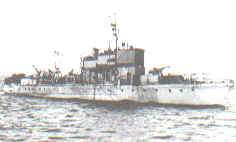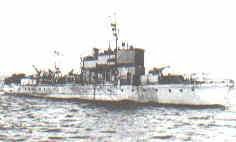
Built in 1940 as a French submarine chaser. (Very interesting story. More Swanage than Portland/Weymouth! (Clarke: GPS; 50 34.96N; 01 56.16W) & (LARN) See note, there is confusion with the CHASSEUR 5 details can be found in Farr: p100.
HMS Carentan – 1943
LARN (Spelt CARANTAN)
Built in 1940 as a French submarine chaser, she was commissioned as a Royal Navy vessel on 08/07/1940, but in 12/1942 was taken over by the Free French. She sank during a force 9 SW gale having capsized. Wreck is owned by a Mr E Bennett who lifted the wreck and moved them to the charted position. The wreck is considered dangerous since there are 20 depth charges remaining, as well as smoke canisters plus 75mm. & 40mm. ammunition in boxes and ready-use lockers. One large gun has been removed from the wreck and was landed at Swanage Pier on 09/08/1989, but not by the owner. In fact her guns were of a rare and unusual type, and the owner, Mr Bennett, was purchased the wreck on 17/09/1970, intended to donate her armament to the Imperial War Museum. A diving team from HMS VERNON were requested to remove the hazardous armament but a report in 1990 still indicated that there were explosive mortars and depth charges around the stern.
DIVERNET
407-ton French submarine chaser, taken over by Royal Navy at fall of France, built 1939. 116ft x 18ft. Armed with 75mm field gun, one 2-pounder, two 20mm Oerlikons, four machine guns and depth charges. Position: 50 34.95N; 01 56.18W. Depth: 32m.
Sunk: 21 December, 1943, when capsized in south-westerly gales off Anvil Point, Dorset, while escorting submarine HMS RORQUAL, Portland for Portsmouth. Six of Free French crew of 23 saved.
Diving: Owned by Swanage skipper Eddie Bennet, who has raised a big gun from bow. Both propellers lifted. Lies on port side on rock and slate bed. Hull has twist in middle. Parts of the superstructure remain, as does much ammunition.
EXCELLENT DETAIL IN WWW.WRECKSITE.EU – Following are notes from the site.
http://www.wrecksite.eu/wreck.aspx?4947 
1 – Six of Free French crew of 23 saved
2 – Sydney H. Goodall, during World War 2. He died when the Carentan sank, one of three British Navy crew to die on this Free French Navy vessel.
3 – My grand uncle, Edouard CORVASCE died on the Chaser 5 “Carentan” December 21, 1943. He was born September 15, 1922, inMarseille, France. He was sailor (“matelot gabier”). He entered FNFL in july 1940, when he was 17 y.o. He was son of Savino CORVASCE (1885, Barletta, Italy – 1967,Marseille,France) and of Chiara ANNELLI (1885, Barletta, Italy – 1947, Marseille, France).
__________________________________________________
Note by Mike Marsh
Name(s): HMS Carentan.
Depth: 30m
Location: Swanage (1/4 mile east of Kyarra site)
Type: Wreck
Marks:
50.34.986N
01.56.210W
Description: French submarine chaser, seized by British and later during WW2 handed over to the Free French. 120ft long with only 20ft of beam and perhaps carrying too much ordinance/weapons? (A heavy gun was bolted to the deck and many depth charges, some of which are still on site!) She capsized and sank on the 21st December 1943. while escorting the incoming British submarine HMS Rorqual in a storm.
Only 6 of the 23 crew survived 1 being picked up by Rorqual and the remainder saved by the Swanage lifeboat from the upturned hull! The lifeboat crew returned to Swanage to get cutting gear from a local garage. then returned to the Carentan in a full gale to try to rescue the sailors trapped in the upturned ship. Unfortunately she had already slipped to her final resting place.
Lots of ammunition and ordinance on this wreck, including depth charges, so leave well alone!
This is a war grave. so please respect it as such.
‘In my youth I had the privilege of hearing first hand the tale of this wreck from “old hands” who were on the lifeboat which answered the call, very moving, and something that obviously had a deep effect on them.’
Mike Marsh.
Text by Mike Marsh.
Note:
LARN also lists the CHASSEUR 5 which is the report from Farr: p100:
This French motor gun boat was escorting a British submarine in heavy seas when she capsized three miles south of Durlston Head. The submarine radioed the N.O.I.C. (Naval Officer in Charge) at Poole who at about 10.30 a.m. requested the Swanage lifeboat to put out. In an increasing SW gale and poor visibility, it took the lifeboat three-quarters of an hour to reach the scene, where they found and rescued three sailors clinging to the keel, two of whom were in a very shocked and exhausted condition. Four others had meanwhile been rescues by the submarine using heaving lines, but 16 were still trapped within the vessel, some of the faces could be seen looking out of the portholes. With no tools to break into the hull and it utterly impossible to board the slippery upturned vessel, the situation was hopeless. A suggestion that the submarine should ram it in an attempt to right her was considered too dangerous. The life boat returned to shore for tools but later returned to find the vessel had sunk. The submarine was already on its way to Portland.
The Coxswain and his crew of five received letters of thanks from the Commander in Chief of the Free French Naval Forces, and after the war all received medals from the French Government. The French lifesaving society (Société Centrale de Sauvetage des Naufragés) awarded Coxswain Robert Brown its silver gilt medal, and its bronze medal to Mechanic Alfred Chinchen and Bowman W. E. Nineham.
Day of Loss: 21
Month of Loss: 12
Year of Loss: 1943
Longitude: 50 34.96
Latitude: 01 56.16
Approximate Depth:
Aliases, aka: CARANTAN
